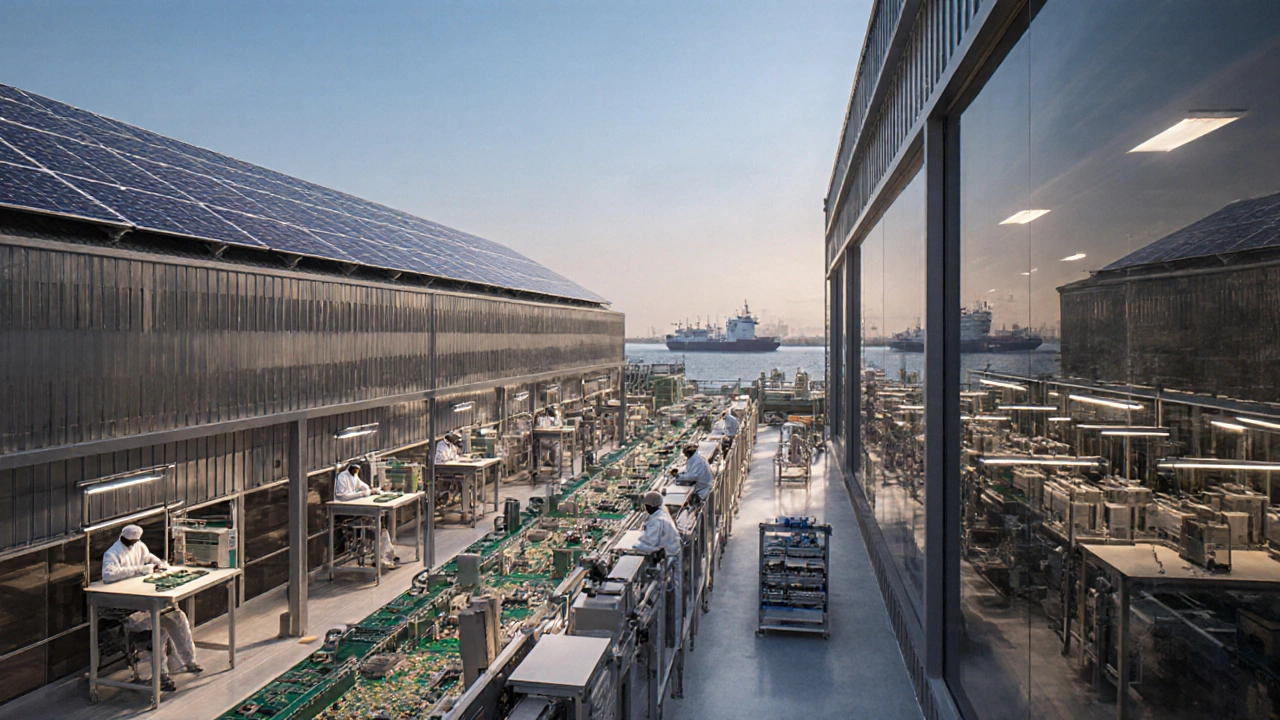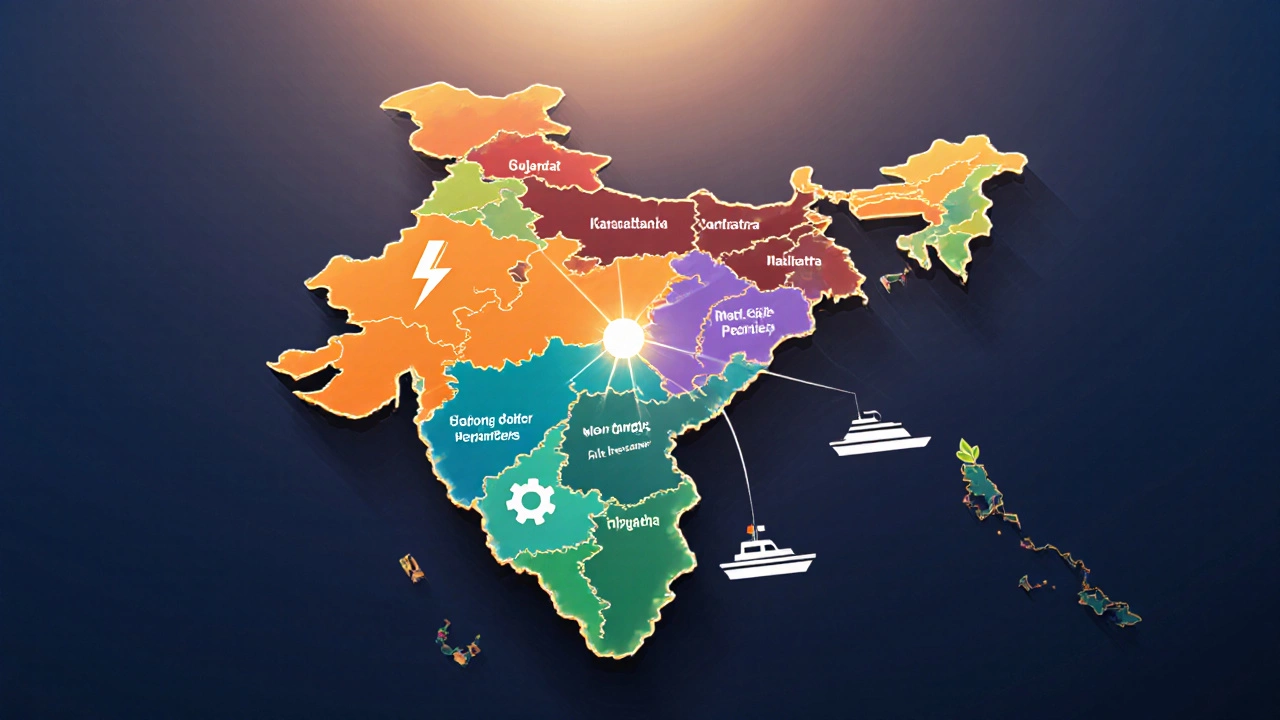Electronics Manufacturing State Selector
Find your ideal electronics manufacturing state
Select your project type and weight priorities to calculate which Indian state is best for your electronics manufacturing needs.
Results
Select your project type and priorities to see the results
Electronics manufacturing hub is a geographic region that offers the right mix of infrastructure, skilled labor, policy incentives and logistics to attract electronic component and device makers. With the Indian government pushing the "Make in India" agenda and earmarking over₹1lakh crore for electronics by 2030, investors are scrambling to pick the state that gives the best return on capital. This guide breaks down the data, the incentives and the on‑ground reality so you can decide whether Gujarat, Karnataka, TamilNadu or another state fits your project.
What decides a "best" state for electronics?
We boiled the decision down to six measurable jobs‑to‑be‑done that every plant manager or investor cares about:
- Assess the quality and cost of industrial infrastructure (power, water, telecom).
- Gauge the availability and affordability of skilled labor for assembly, testing and R&D.
- Compare government incentives - capital subsidies, tax holidays, EPCG (Export Promotion Capital Goods) benefits.
- Analyse logistics efficiency - proximity to ports, airports, and major highways.
- Review the state's export performance and existing electronics ecosystem.
- Understand the regulatory ease - land acquisition time, single‑window clearances, GST compliances.
Answering these jobs gives you a clear picture of which state can deliver the fastest ramp‑up and the highest margin.
Top five states in 2025
Based on data from the Ministry of Electronics & Information Technology (MeitY), state industrial development corporations and recent private‑sector announcements, the following five states consistently lead the rankings.
| State | Infrastructure Rating (0‑10) |
Average Labor Cost (₹/day) |
Key Incentives | Export Share of India’s Electronics | FY2024‑25 New Investment (₹bn) |
|---|---|---|---|---|---|
| Gujarat | 9.2 | 850 | 10% capital subsidy, EPCG waiver, 5‑year tax holiday | 28% | 12,400 |
| Karnataka | 8.8 | 780 | 50% subsidy on land & utilities, Innovation Hub grants | 22% | 10,900 |
| TamilNadu | 8.5 | 800 | 7‑year GST exemption, SEZ‑friendly policies | 20% | 9,800 |
| Maharashtra | 8.0 | 870 | 3‑year tax holiday, Dedicated Electronics Zones | 15% | 8,500 |
| Telangana | 7.8 | 730 | Land at 50% market price, Startup incubation grants | 12% | 6,300 |

Deep dive into each state
Gujarat has become the poster child for electronics manufacturing thanks to its world‑class industrial corridors like Dholera and the Gujarat International Finance Tec‑City (GIFT). The state offers a 99.9% power reliability rate, dedicated water supply for tech parks, and a fiber‑optic backbone reaching 95% of factories. Labor costs are slightly higher than the national average, but the skill pool includes over 120,000 technicians trained in PCB assembly and IoT device testing under the Gujarat Electronics Skill Initiative.
Policy‑wise, Gujarat’s "Electronics Manufacturing Promotion Scheme" (EMPS) provides a 10% capital subsidy up to ₹30crore, plus a 5‑year exemption from the state GST. The EPCG scheme is fully waived for projects above ₹250crore, making high‑value imports for robotics cheap. The state’s ports of Mundra and Kandla handle 60% of India’s electronics exports, cutting ocean‑shipping lead times to the Middle East and Europe by 3‑4days.
Karnataka remains a research powerhouse because Bengaluru houses the largest tech talent pool in India. The Karnataka State Electronics Development Corporation (Keedc) runs two dedicated electronics parks - Electronics City and Bangalore SEZ - each equipped with clean rooms, test labs and on‑site customs clearance. Labor cost is marginally lower than Gujarat, while the average salary for PCB designers sits at ₹7.5lakh per annum. The state’s flagship "Karnataka Electronics & IT Policy 2024" offers 50% subsidy on land acquisition for projects over 20acres, and a 3‑year tax holiday for R&D centres. Export figures are strong, driven by a thriving smartphone component ecosystem.
TamilNadu leverages its coastal location and the massive Kattupakkam Electronics Complex near Chennai. The state’s power infrastructure boasts a 99.5% uptime, and a new 6GW solar park powers 30% of the complex’s energy needs. Labor is competitively priced, and the "TamilNadu Electronics Manufacturing Incentive" gives a 7‑year GST exemption and a 20% rebate on capital equipment for firms that set up in the SEZ. The Chennai Port is the second‑largest gateway for electronics, providing direct links to Southeast Asian markets.
Maharashtra benefits from the Mumbai‑Pune corridor, where logistics firms specialize in high‑value electronic goods. The state’s "Electronics Production and Export Promotion" programme offers a 3‑year tax holiday, and its dedicated "Maharashtra Electronics Hub" (MEH) provides ready‑made factory spaces with built‑in testing rigs. However, higher land costs and congested traffic can add to operating expenses.
Telangana is an up‑and‑coming player, anchored by the Hyderabad Information Technology Park and the newly announced "T-Hub Electronics Zone". The state gives land at 50% of market price for projects above ₹100crore and runs a "Startup Incubation Grant" of up to ₹5crore for IoT and AIoT ventures. Labor costs are the lowest among the top five, but the ecosystem is still maturing, and the nearest major seaport (Visakhapatnam) adds an extra day to shipping.
How to choose the right state for your project
- High‑volume consumer electronics - Prioritize port proximity and power reliability. Gujarat or TamilNadu usually win.
- R&D‑intensive or IoT devices - Look for talent clusters and research grants. Karnataka excels.
- Cost‑sensitive assembly - Labor cost and land subsidies matter most. Telangana offers the best price‑performance ratio.
- Exports to Europe or the Middle East - Choose ports with direct liner services. Gujarat’s Mundra and TamilNadu’s Chennai are top choices.
Run a simple scoring model: assign weight 1‑5 to each of the six jobs‑to‑be‑done, multiply by the state’s score in the table, and sum up. The highest total points to the state that aligns with your strategic priorities.

Common pitfalls and how to avoid them
Even the best‑ranked state can trip you up if you ignore local nuances. Here are three traps that catch newcomers:
- Assuming "one‑stop clearance" means instant approval. In Gujarat, the single‑window portal speeds paperwork, but land‑use clearances still require a 30‑day municipal review. Engage a local consultant early.
- Underestimating power quality. In some parts of Maharashtra, voltage fluctuations can damage sensitive test equipment. Invest in UPS and voltage stabilizers; many parks offer a shared backup‑power service.
- Ignoring GST compliance nuances. The GST exemption in TamilNadu applies only to units registered as "Electronics Manufacturers" under the state's portal. Register correctly or you’ll lose the benefit.
Key Takeaways
- Gujarat leads on infrastructure, export logistics and capital subsidies - ideal for large‑scale consumer electronics.
- Karnataka offers the deepest talent pool and R&D incentives - perfect for innovation‑driven projects.
- TamilNadu balances port access with a strong GST holiday, making it a solid all‑round choice.
- Maharashtra provides premium logistics but at higher land and labor costs.
- Telangana wins on cost and startup support, though the ecosystem is still growing.
Frequently Asked Questions
Which Indian state offers the highest capital subsidy for electronics factories?
Gujarat’s Electronics Manufacturing Promotion Scheme (EMPS) provides up to a 10% capital subsidy, capped at ₹30crore, which is the highest among the top five states.
How does the EPCG waiver work in Gujarat?
Projects with a capital outlay above ₹250crore can import capital goods without paying customs duty, provided they export at least 30% of their production within five years.
Is Bangalore still the best place for electronics R&D?
Yes, Bangalore (Karnataka) hosts the largest concentration of electronic design engineers, several testing labs, and strong university‑industry links, making it the top R&D hub.
What are the land cost differences between Gujarat and Telangana?
In Gujarat, industrial land averages ₹10lakh per acre, while Telangana offers land at 50% of market price - roughly ₹5lakh per acre for eligible projects.
How long does it take to get a GST exemption in TamilNadu?
Once the factory is registered as an Electronics Manufacturer, the GST exemption is granted within 15business days through the state’s online portal.






